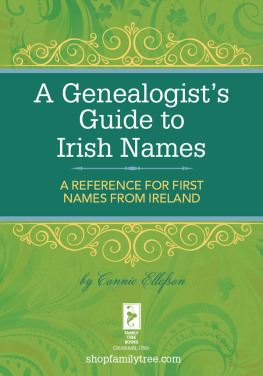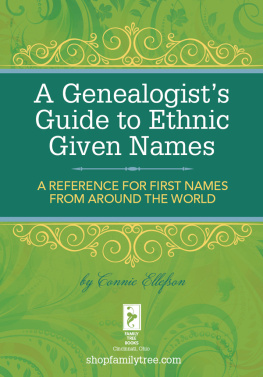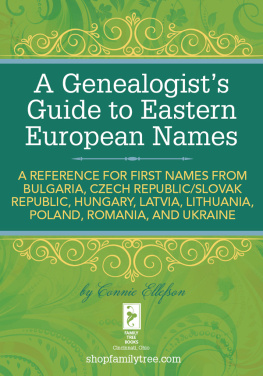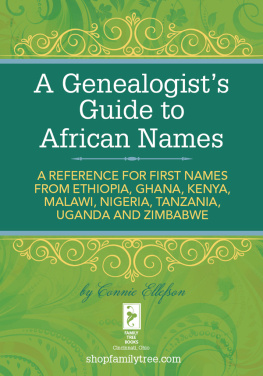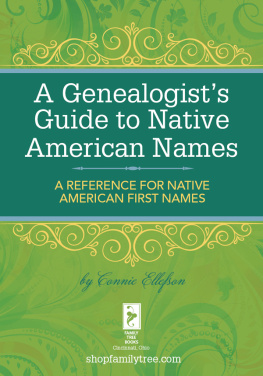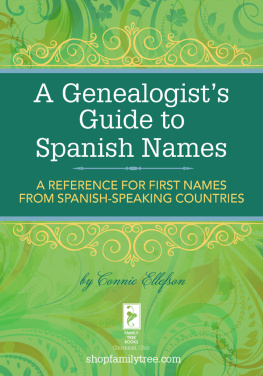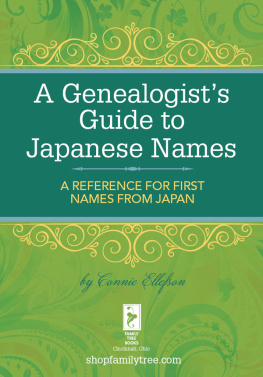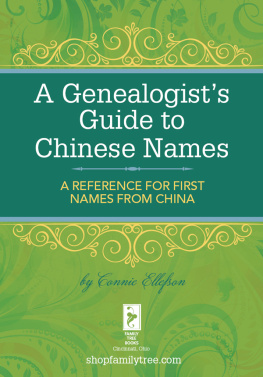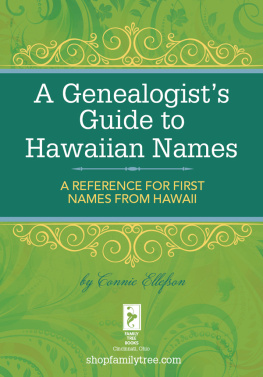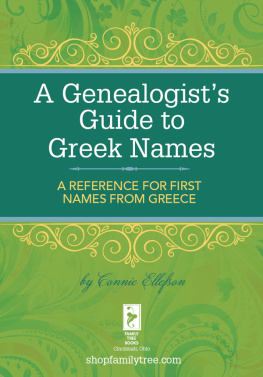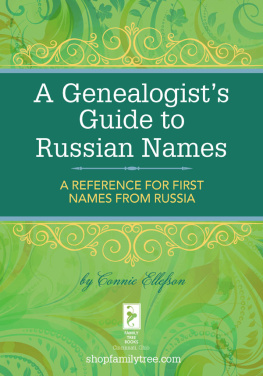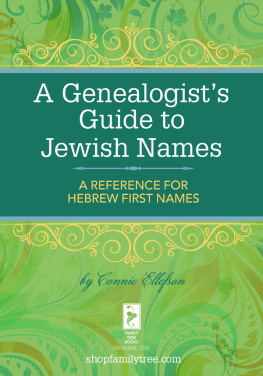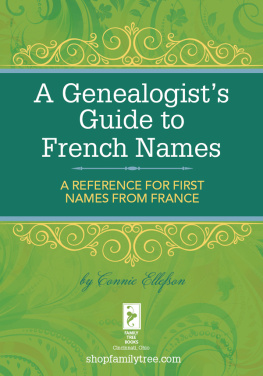A Genealogists Guide to Irish NamesA REFERENCE FOR FIRST NAMES FROM IRELANDby Connie Ellefson
Cincinnati, Ohio shopfamilytree.com
Ireland
History
An Irishman sailed with Columbus to the New World, another lived in the colony at Jamestown, Virginia, in 1607, and another sailed with Henry Hudson. During the 1600s and 1700s, thousands of Irish immigrated as indentured servants (working several years to pay off their transatlantic passage), religious refugees (primarily Catholics), transported political prisoners and voluntary immigrants. Of 200,000 Irish-born immigrants in the U.S. by 1760, an estimated 40,000 were true Irish, the rest being Scotch-Irish (see chapter on Scotland). Many Scotch-Irish settled in deep, southern backwoods areas in order to be as far from the English as possible. Between 1820 and 1840, one-third of immigrants to America were born in Ireland; during the 1840s, just over 45 percent of the arrivals were Irish.
After about 1815, landlords had been gradually increasing rents to exorbitant rates as well as summarily turning out their tenant farmers in order to expand their own farming operations. This practice, combined with the potato famine of 1845, caused a constant state of near-starvation among peasant farmers. Between 1845 and 1851, approximately one million Irish died of starvation and disease, and another million emigrated to escape the deprivation. After the famine was over, Irish continued to emigrate. Emigration became for many a predictable life event, to be fit in between birth and death. Irish immigration reached a peak in the 1850s, when over 900,000arrived in the U.S.
Large numbers continued to arrive through the 1920s although the percentage of the total immigrants gradually declined. A total of 4.7 million Irish immigrated to the U.S. between 1820 and 1982. Most Irish immigrants settled in the Northeast, although significant numbers then migrated to the West Coast states after staying in the eastern cities for a while. In 1870, Irish were the largest foreign-born group in California, and from the early nineteenth century, Irish were always among the first groups in the drive west. However, they were less likely to homestead than some other immigrant groups, because in Ireland they had been used to working small plots of established ground during the day and joining their near neighbors in the evening for friendly gossip and relaxation.
The lonely life of a sodbuster, miles from the closest neighbor, did not suit the Irish temperament. As a result, four out of five Irish immigrants settled in cities, working as laborers, domestics and factory workers. After World War I, Irish emigration resumed; however, the destination then was much more likely to be England than America. Immigration from Ireland was very low during the 1930s and 1940s (as from all countries). After World War II, it averaged about 5,000 each year in the 1950s, and has now dwindled to about 1,000 per year.
Naming Traditions
Old Irish names are very popular in Ireland now.
The Irish language is a Celtic language closely related to Scottish Gaelic and spoken now only in certain areas along the western seaboard. In attempting to decipher the Irish pronunciation, one can come to appreciate the difficulty people must have in learning English. Its been pointed out that the letters ough can be pronounced five different ways in English with no real clue as to which one goes where (plough, trough, thought, rough and though). The Irish language has similar irregularities as well as a different syntax. Several purely Irish names have been included in the name list as well as the Anglicized versions of them that have developed in Ireland.
Irish Female Names
Abaigeal (AB-i-gel) (H) father of joy; Abigail, Abaigh (AB-ee), Abbie
Affrica (Gael) pleasant
Agata (Gr) good; Agatha
Aghna (EH-nuh) Irish for Agnes (Gr) gentle, pure; Ina
Aifric (A-frik) (Celt) pleasant; Afric, Africa, Aphria
Aigneis (AG-nesh) (Gr) gentle, pure; Agnes
Ailbhe (AL-vyuh) (OGer) noble, bright; Alvy, Elva (boys name, too)
Aileetl (A-leen) (Gr) light; Ellen
Ailidh (A-lee) (OGer) noble, kind; Alley
Ailfs (A-lish) (OGer) noble, kind; Alicia, Elsha, Ailis, Ailse (A-lish)
Aimilfona (a-mil-EE-nuh) (Teut) industrious; Amelia
ine (AN-yuh) (Celt) joy; Anne Aingeal (AN-gel) (Gr) messenger; Angela
Aisling (ASH-ling) vision, dream; Ashling
Aithne (ATH-nyuh) (Celt) fire; Aine, Ena, Ethne
Alastrona (al-is-TREE-nah) (Gr) defender of mankind; Alastrina, Alexandra
Alma (Celt) good
nna (H) differs from native
Aine; grace; Anne
Annsts (AN-stahs) (Gr) resurrection; Anastasia
Aodhnait (EH-nat) ancient Irish name; Enat, Ena, Eny
Aoibheann (WEE-vuhn) ancient Irish name; Eavan
Aoife (WEE-fyuh) (H) life; Eva
Arienh (A-reen) (Gael) pledge
Arlana (Celt) pledge
Bab (BEHB) pet name; Babe
Birbre (BAR-bruh) (Gr) a stranger; Baibin (BAB-een), Barbara
Bbhinn (BEH-vin) melodious lady; Bevin
Bean Mh (BEN-vee) Lady of Meath; Benvy
Bernadette feminine for Bernard (OGer) courage of a bear
Blair (Celt) from the plain
Blanche (L) white
Blthnaid (BLA-na) blossom, flower bud; Florence
Blinne diminutive of Moninne (an Irish saint)
Brenna (Celt) dark hair
Bretta (Celt) from Britain; Bret, Brit, Brite, Brittany, Brita
Briana (Celt) strong
Bride (Celt) strength; Briget, Bridget, Brietta
Brghid(BRIDE)(Celt) strength; Brid(BREED), Bride, Breeda
Brigid (Celt) strength; Bridget
Brina (Celt) protector
Brit (Celt) speckled
Cait (KATE) (Gr) pure; Caiti (KAT-ty)
Caitlin (KAT-leen) (Gr) pure; Caitilin
Caitrn (KAT-reen) (Gr) pure;
Caitriona (kat-TREE-nuh), Catherine
Caoilfhionn (KEE-lin) (Celt) slender, fair; Keelin
Caoimhe (KEE-vy) gentleness, beauty, grace; Keavy
Cara (Celt) friend; Carrie, Carry
Carmel (H) vineyard
Christine (Gr) Christian
Ciannait (KEE-nat or KIN-nat) ancient; Kinnat, Keenat
Ciar (KEER) saint; Ciara, Ceire (KEHR), Keara
Cinnie (Celt) beauty
Clare (L) bright, clear Clodagh (KLOH-dah) river in County Tipperary
Cordelia (Celt) jewel of the sea
Cristn (KRIS-teen) (L) Christian; Cristiona (kris-TEE-nuh)
Damhnait (DEV-nat) poet; Devnet, Downet, Dymphna
Dana (Celt) from Denmark
Darcy (OFr) from Arcy
Dearbhil (DER-vahl) true desire; Derval
Deirdre ancient Irish name, mythological heroine; young girl; Derdre
Derval true desire
Devnet poet; Downet
Doireann (DOR-en) sullen or diminutive of
Dorothy (Gr) gift of God; Dorren
Doreen (Celt) moody Duana (Gael) song
adaoin (eh-DEEN) feminine for Edwin (OGer) happy friend; Edwina
EdanaNext page
